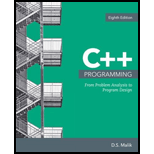
Consider the definition of the class product Type as given in Exercise 8.
Answer the following questions. (1, 2, 3, 5, 7)
Write the definition of the function set so that instance variables are set according to the paramaters. Instance variables quantitieslnStock, price, and discount must be nonnegative.
Write the definition of the function print to output the values of the instance variables.
Write the definition of the function setQuantitiesInStock to set the value of the instance variable quantitiesInStock according to the parameter.
Write the definition of the function updateQuantitiesInStock to update the value of instance variable quantitiesInStock by adding the value of the parameter.
Write the definition of the function getQuantitiesInStock to return the value of instance variable quantitiesInStock.
Write the definition of the function setPrice to set the value of the instance variable price according to the parameter.
Write the definition of the function getPrice to return the value of the instance variable price.
Write the definition of the function setDiscount to set the value of the instance variable discount according to the parameter.
Write the definition of the function getDiscount to return the value of the instance variable discount.
Want to see the full answer?
Check out a sample textbook solution
Chapter 10 Solutions
C++ Programming: From Problem Analysis to Program Design
 C++ Programming: From Problem Analysis to Program...Computer ScienceISBN:9781337102087Author:D. S. MalikPublisher:Cengage Learning
C++ Programming: From Problem Analysis to Program...Computer ScienceISBN:9781337102087Author:D. S. MalikPublisher:Cengage Learning C++ for Engineers and ScientistsComputer ScienceISBN:9781133187844Author:Bronson, Gary J.Publisher:Course Technology Ptr
C++ for Engineers and ScientistsComputer ScienceISBN:9781133187844Author:Bronson, Gary J.Publisher:Course Technology Ptr

